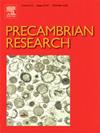Petrochronology and geochemistry of migmatites from the Assam-Meghalaya gneissic complex (NE India): Implications for the crustal anatexis and reworking during Gondwana assembly
IF 3.2
2区 地球科学
Q2 GEOSCIENCES, MULTIDISCIPLINARY
引用次数: 0
Abstract
The extensive Proterozoic migmatisation in the Assam-Meghalaya Gneissic Complex (AMGC) is critical for understanding its Precambrian tectonic evolution. The present study reports the occurrence of distinct lithologies in Guwahati and adjoining regions, providing new insights into the Proterozoic high-grade migmatisation events in the central AMGC. This is achieved through an integrated analysis of structures, mineral chemistry, phase equilibrium modelling, whole-rock geochemistry and zircon-monazite geochronology. The gneisses and amphibolites experienced three deformation episodes (D1, D2 and D3), and migmatisation occurred during the D2 deformation. Phase equilibrium modelling results indicate that the quartzo-feldspathic gneisses and amphibolites experienced peak P-T metamorphism at 5.3–8.0 kbar/720–730 °C and 5.8–7.0 kbar/690–700 °C, respectively. The melt re-integration approach for the quartzo-feldspathic gneisses reveals that the prograde metamorphism occurred through the sub-solidus breakdown of muscovite, followed by the breakdown of biotite during the peak metamorphic event. U-Pb zircon geochronology yielded concordant upper intercept ages of 1674–1610 Ma, representing a Mesoproterozoic igneous protolith for the migmatites. Discordant lower intercept ages (512–426 Ma) and widespread U-Th-total Pb monazite ages (499–470 Ma) constrain the timing of high-grade metamorphism and partial melting in the central AMGC. Geochemically, the leucosomes developed in quartzo-feldspathic gneisses and amphibolites show K-rich and Ca-rich compositions. According to trace element and REE patterns, the K-rich and Ca-rich leucosomes in the quartzo-feldspathic gneisses and amphibolites were formed by partial melting of granitic or metasedimentary protoliths and mafic protoliths, respectively. Combining P-T and geochronological results presented in this study with the existing data, we propose that the central AMGC largely evolved in the hinterland region during the Cambrian-Ordovician (499–470 Ma) collision event. The correlation of widespread Late Neoproterozoic partial melting, high-grade metamorphism and magmatism in the Guwahati region with similar events in western Australia and Antarctica indicate that the central and eastern AMGC represents a convergent margin evolved during the assembly of the Gondwana supercontinent.
阿萨姆-梅加拉亚片麻岩群(印度东北部)岩浆岩的岩石年代学和地球化学:冈瓦纳组装过程中地壳断裂和再加工的影响
阿萨姆-梅加拉亚片麻岩群(AMGC)中广泛的新生代岩浆活动对于了解其前寒武纪构造演化至关重要。本研究报告了在古瓦哈提及其邻近地区出现的独特岩性,为了解阿萨姆-梅加拉亚片麻岩群中部的新生代高品位岩化事件提供了新的视角。这是通过对结构、矿物化学、相平衡建模、全岩地球化学和锆英石-独居石地质年代学的综合分析实现的。片麻岩和闪长岩经历了三次变形(D1、D2 和 D3),在 D2 变形过程中发生了移绿作用。相平衡建模结果表明,片麻岩和闪长岩分别在5.3-8.0千巴/720-730 °C和5.8-7.0千巴/690-700 °C经历了峰值P-T变质作用。对石英长片麻岩的熔体再整合方法显示,在峰值变质事件中,通过黝帘石的亚固结分解发生了顺级变质,随后是生物玢岩的分解。U-Pb锆石地质年代学得出了一致的上截距年龄(1674-1610Ma),代表了岩浆岩的中新生代火成岩原岩。不一致的下截距年龄(512-426 Ma)和广泛的U-Th-总铅独居石年龄(499-470 Ma)确定了AMGC中部高品位变质和部分熔融的时间。从地球化学角度来看,发育在曲长片麻岩和闪长岩中的白云母显示出富钾和富钙的成分。根据微量元素和稀土元素的形态,闪长片麻岩和闪长岩中的富钾和富钙白云母分别是由花岗岩或变质岩原岩和黑云母原岩部分熔融形成的。结合本研究中的P-T和地质年代结果以及现有数据,我们提出,在寒武纪-奥陶纪(499-470 Ma)碰撞事件期间,AMGC中部主要在腹地地区演化。古瓦哈提地区广泛存在的新元古代晚期部分熔融、高级变质和岩浆活动与澳大利亚西部和南极洲类似事件的相关性表明,AMGC中部和东部代表了冈瓦纳超大陆组装期间演化的汇聚边缘。
本文章由计算机程序翻译,如有差异,请以英文原文为准。
求助全文
约1分钟内获得全文
求助全文
来源期刊

Precambrian Research
地学-地球科学综合
CiteScore
7.20
自引率
28.90%
发文量
325
审稿时长
12 months
期刊介绍:
Precambrian Research publishes studies on all aspects of the early stages of the composition, structure and evolution of the Earth and its planetary neighbours. With a focus on process-oriented and comparative studies, it covers, but is not restricted to, subjects such as:
(1) Chemical, biological, biochemical and cosmochemical evolution; the origin of life; the evolution of the oceans and atmosphere; the early fossil record; palaeobiology;
(2) Geochronology and isotope and elemental geochemistry;
(3) Precambrian mineral deposits;
(4) Geophysical aspects of the early Earth and Precambrian terrains;
(5) Nature, formation and evolution of the Precambrian lithosphere and mantle including magmatic, depositional, metamorphic and tectonic processes.
In addition, the editors particularly welcome integrated process-oriented studies that involve a combination of the above fields and comparative studies that demonstrate the effect of Precambrian evolution on Phanerozoic earth system processes.
Regional and localised studies of Precambrian phenomena are considered appropriate only when the detail and quality allow illustration of a wider process, or when significant gaps in basic knowledge of a particular area can be filled.
 求助内容:
求助内容: 应助结果提醒方式:
应助结果提醒方式:


